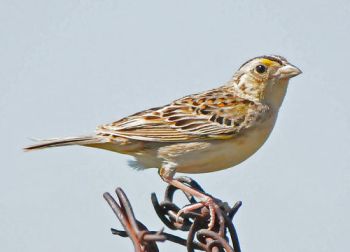Identification
This small sparrow, Ammodramus savannarum, only 4 - 5 inches in length, is commonly confused with other sparrows on the acreage in Nebraska. The Grasshopper sparrow has a short pointed tail. The head and body are medium to dark chestnut brown with only minor lighter coloration. The underside is yellowish cream with no stripes.

For more pictures, call recordings and distribution maps visit
- All About Birds, from the Cornell Lab of Ornithology
- Guide to North American Birds, Audobon
Habitat
The Grasshopper sparrow prefers open habitats such as prairies, mowed fields, and meadows. They are commonly seen perched on tall thick stands of grasses or fence rows.
These sparrows feed primarily on the ground in open locations within its short grassland habitat. They feed on a great variety of fallen seeds, dried flower heads, and grass seeds. They get their common name from their grasshopper-like call used to establish territories for nesting.
In Nebraska the Grasshopper sparrow populations are declining. It is thought that grassland habitat loss and destruction is linked to their lower numbers. Habitat fragmentation, being broken into smaller pieces, is likely an additional factor in the reduction the Grasshopper sparrow's abundance.
Nesting & Young
Grasshopper sparrows construct their nests on the ground at the base of a clump of vegetation, consisting of thick stemmed grasses with over-hanging vegetation. This creates a protected house that is tent-shaped with 2 - 3 lateral entry points.
Pairs will make a new nest for each of the 2 - 3 broods produced per year. The female incubates the clutch of 3 - 6 eggs while the male defends the nest from predators and intruders. Both males and females will cautiously walk from the nest, then at a short distance take flight so as not to reveal the location of the nest.
Nestlings hatch at about 10 days and are cared for by both the female and male. Young leave the nest after an additional 10 days. The very young are incapable of flight and walk along the ground in dense cover to avoiding possible predation.

